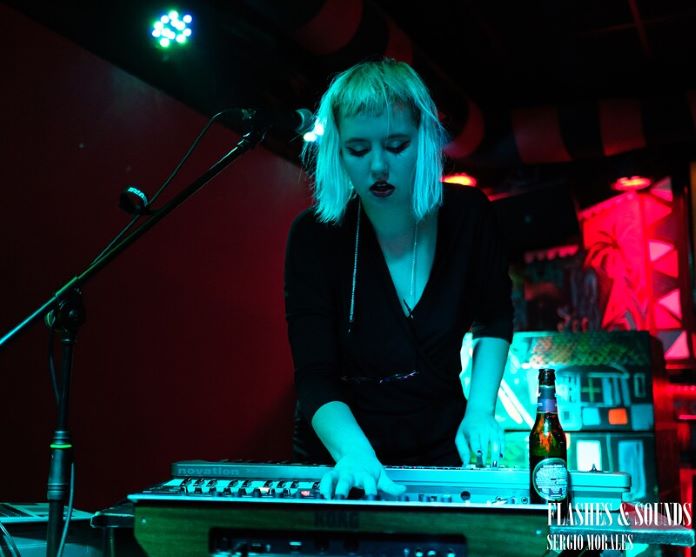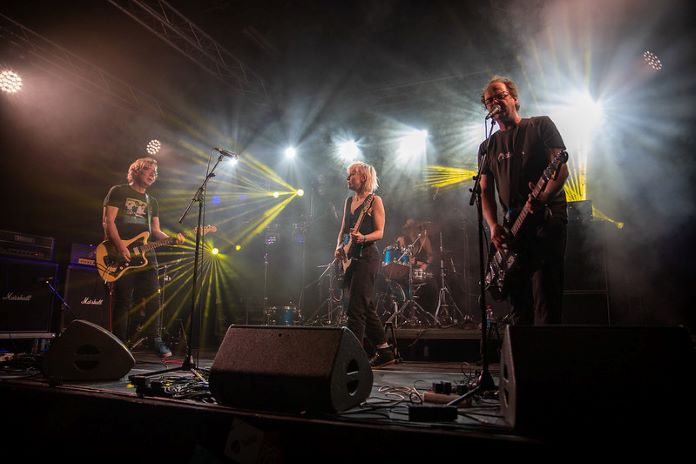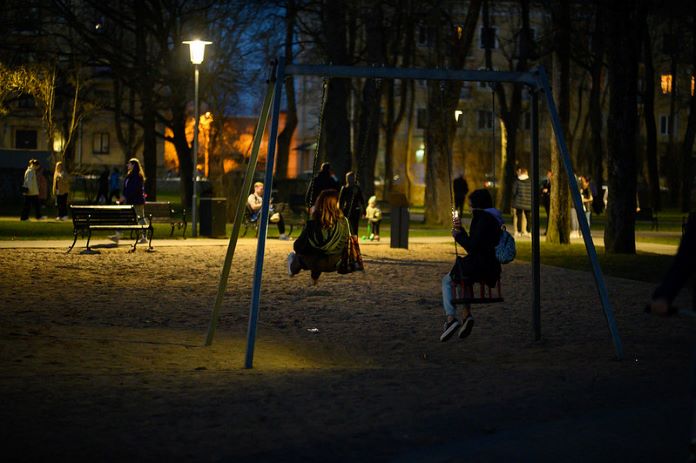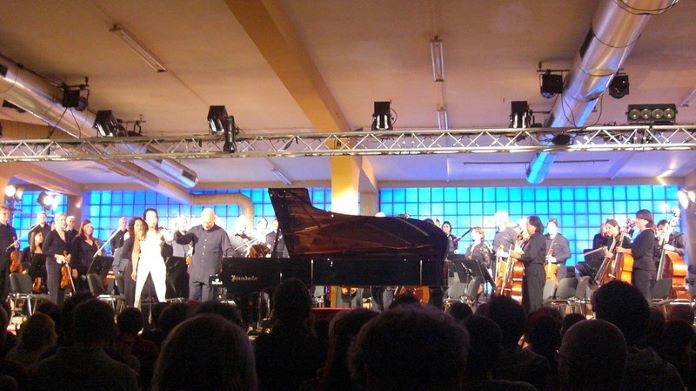
Balaklava Blues
Floating Points, Tirzah, Kaelan Mikla, Balaklava Blues, Arvo Pärt
Tallinn-Narva Music Week, Estonia, May 4-8, 2022,
May 31, 2022
Photography by Andi Kokk (lead photo)
Web Exclusive
![]()
When Russia’s invasion of Ukraine began in earnest in the early hours of Thursday 24th February, the effects for Tallinn Music Week would be just one more example of how nothing in the lives of many in Eastern Europe and the Baltics would ever be the same again. How this catastrophic act had redrawn new and often painful fault lines, and added brutal urgency to pre-existing tensions.
Coming out of a difficult two years as a consequence of the Covid-19 pandemic, Tallinn Music Week - the international music industry conference and biggest showcase festival in the Nordic-Baltic region - quite understandably thought that the worst was behind them and that nothing could match the challenges of the pandemic era. How did the festival respond to the pandemic? The 2020 festival was originally scheduled for the end of March and the difficult decision to postpone was taken at two weeks’ notice. Remarkably - and testament to the tenacity and flexibility of the organisers - in August 2020 the festival was one of the few large music gatherings in Europe to be given the green light that summer. In 2021, those same organisers gritted their teeth and persevered to host an Autumn edition of the festival - coinciding with the 80th Jubilee of Eesti Konsert (the Estonian Concert Organisation that has contributed fiercely to the nation’s music scene and heritage) and the 30th anniversary of Estonian independence. Organisers could have been forgiven for thinking that 2022 could have marked a much needed return to business as usual.

“On 24th February the world changed. And it concerns us all” outlined festival director and founder Helen Sildna in the weeks following the invasion, “Since 2018 we have also been organizing Station Narva in the easternmost border city of Estonia where the European Union starts from. TMW will take place in Tallinn and Narva as a statement of solidarity: each of us in Europe is as safe and strong as our border states and communities. We would like to invite you on a journey with us. We hope that it will be a unifying and insightful experience – proof of music and culture creating collaboration and solidarity. We are all connected. Unity is our defence.” Tallinn Music Week became Tallinn-Narva Music Week.
In conversations and bars around Tallinn as the festival began, any sense of celebration was doused in gallows humour, as networks of artists, journalists, DJs, booking agents, promoters and more met for the first time in months with the world changed around them. Some breathless coverage of Eastern European music scenes in 2022 can, however, forget that these questions are not entirely new. Russia’s annexation of Crimea in 2014 created challenges for Ukrainian underground musicians engaging in Russian networks. In general, personal relationships were still easy to prioritise between likeminded artists over political priorities. Clearly this is no longer possible. One is left with a sense of acknowledgement at the reasons why the boycott has had to happen, whilst mourning the fact that, as a consequence, so much of the progress made by Russian music networks and underground scenes since Perestroika have been wiped out. It goes without saying, the most important solidarity of all at this point is with Ukrainian citizens. The showcase festival, consequently, no longer has Russian performances, but carries on with an exciting, diverse and often outright remarkable line-up that showcases the best of Eastern European and Baltic contemporary music culture from electronic reimagining of traditional folk ideas to sharp Eastern European hyperpop. The conference, likewise, is a sobering reminder that challenges entirely separate to the challenges associated with February 24th 2022 still exist - panel discussions groan under the weight of vinyl pressing plant delays, Brexit complications (it is not Anglocentric to remember that the United Kingdom is a large market and out foolhardy political delusions have consequences for music networks around Europe) and the reckoning with the financial consequences of the pandemic.

That Tallinn Music Week is able to deliver what it does in Narva is a remarkable and admirable feat of logistics and ambition. The bridge over the Narva river connects the EU with Russia - Narva stands eye to eye with the Russian town of Ivangorod, and the city’s population is more than 80 per cent Russian, with Ukrainian, Belarusian and Estonian minorities. Much of the old Baroque city was destroyed by air raids at the end of the Second World War, and as such Narva is archetypally Soviet in appearance. Kreenholm Island - two large textile mills, accessible via a large bridge - was a product of that Soviet reconstruction. A planned company town was built around this. Here, however, it’s the site of terrific performances by a diverse range of artists including Tirzah and Floating Points. Sound and light installations On the Border and Border Light highlight the identities of those living in this space, and asks visitors to consider life on the border at this uniquely challenging and complex moment.
Redolent of the respect with which the Estonian state holds events such as Tallinn Music Week, President Alar Karis opens proceedings here. “We have recently seen many examples of what music can do” he points out, eloquently, “We have seen a musician heading into battle in the heart of Ukraine singing a traditional song about the red viburnum, turning it into an anthem for peace recognised the world over. The song gives hope and encourages to stand together. We’ve seen a pianist, wearing body armour, playing Chopin in front of the Irpin cultural centre, a building destroyed by bombs…We’ve seen children, mothers, fathers, grandmothers, grandfathers, friends and strangers singing in bomb shelters, metro stations, among ruins.”

Meanwhile, the most poignant reminder exists during a performance in Narva’s large and ornate orthodox church, as the Estonian Philharmonic Chamber Choir perform the religious infused minimalism of Estonian composer Arvo Pärt. The voices soar as sunlight blazes through stained glass. The music of Pärt is inextricably linked with the horrors of the 20th century, and tells a story about Estonian endurance against a backdrop of those horrors. But most importantly, it tells a story about art in the face of atrocity, and the human capacity to express, create and innovate regardless of the challenges and nightmares of the world outside. At Tallinn-Narva Music Week, that spirit was evident in boundless supply.

Current Issue

Issue #72
Apr 19, 2024 Issue #72 - The ‘90s Issue with The Cardigans and Thurston Moore
Most Recent
- Descendents, Circle Jerks @ Brooklyn Paramount, NYC, April 13, 2024 (Review) — Descendents, Circle Jerks
- Bat For Lashes Shares a Cover of Baauer’s “Home” From Her New Album (News) — Bat For Lashes, Baauer
- Premiere: Veronica Lewis Shares New Single “Disconnected” (News) — Veronica Lewis
- The Decemberists Share New Song “All I Want Is You” (News) — The Decemberists
- Ella McRobb Releases New Single “Slow Motion Heartbreak” (News) — Ella McRobb

Comments
Submit your comment
There are no comments for this entry yet.